‘Behemoth’ is a word which springs to mind or, perhaps more nautically, ‘leviathan’.
- The silence! Almost eerie.
- Multiple areas for relaxing
- Quality finishes wherever you look
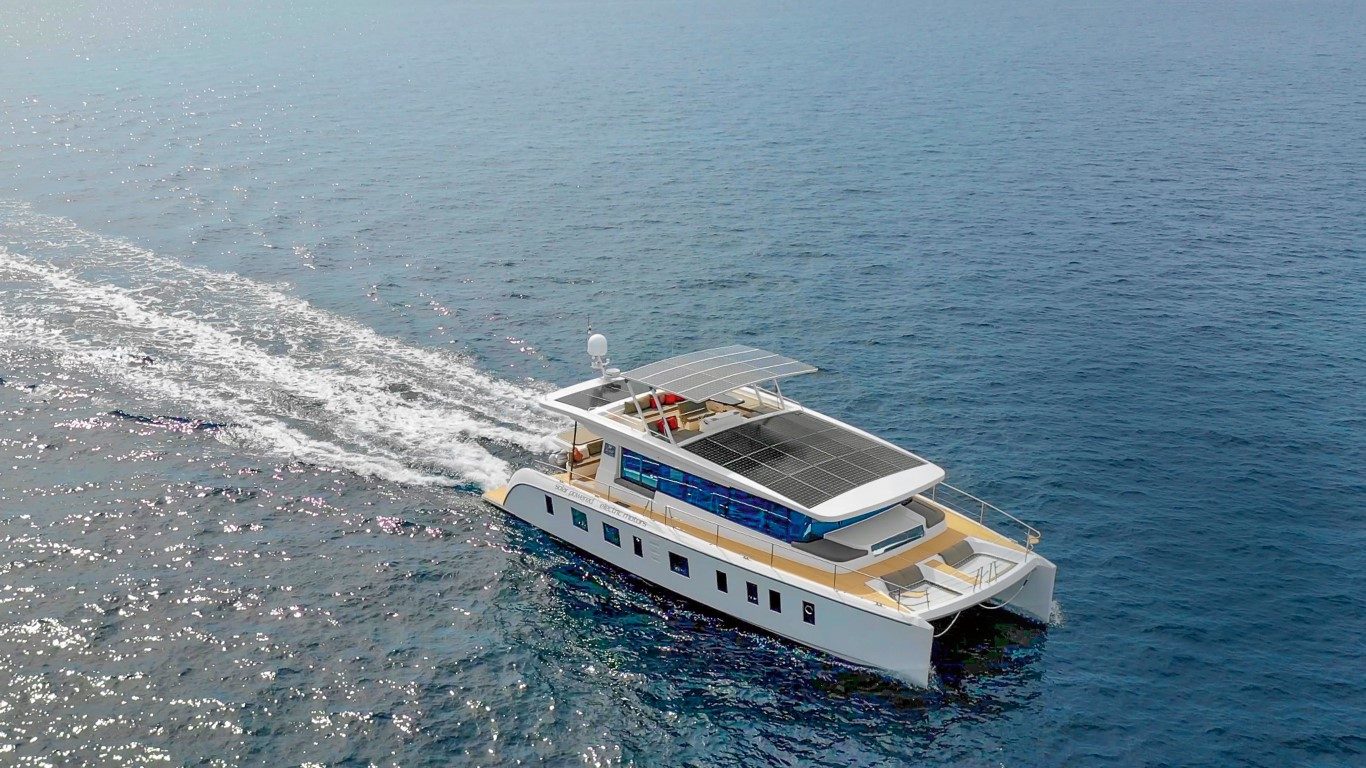
The solar-powered Silent 55 catamaran is successfully pioneering renewable power in a quality and seaworthy design.
Solar cell development is a moving at pace which is creating more uses for it, something Silent Yachts company founder Michael Köhler is acutely aware of. After many years of voyaging on conventional power boats it led him and wife Heike to build their first electric prototype which they sailed for five years and 15,000nm before founding the company and constructing their first production Solarwave 46 in 2009. She was the first renewable-powered blue-water catamaran.
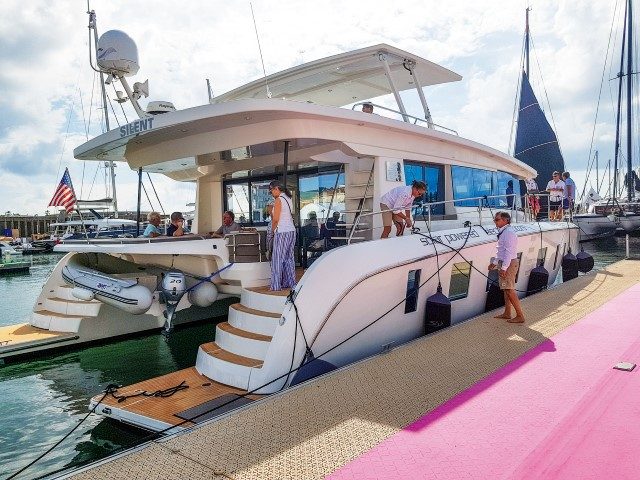
I first met the Köhlers in 2017 when they arrived at La Grande Motte boat show with the Silent 64, which I took out for sea trials. I recall gliding along on the Mediterranean at 10 knots while the twin electric motors hummed quietly, consuming 64 kilowatts, before we throttled back to a cruising speed of 6.6 knots for a more sustainable consumption of 31 kilowatts. I steered with a Raymarine autopilot dial and the twin throttles (but a conventional wheel clips into place for traditionalists).
The latest boat, the Silent 55, has advanced substantially from the 64, especially with the developments in much more powerful lithium batteries. Along with the Silent 55 and the Silent 64, the other models in the range are the Silent 55 VIP Ferry and the upcoming Silent 79.
The electric proposition
The Silent Yachts proposition to buyers is that their systems require hardly any maintenance and produce no fumes or noise so the operational costs are substantially lower compared to power yachts using more traditional propulsion systems. This Silent 55 cruises in the remote Mergui Archipelago in Myanmar during winters so has to be self-sufficient.
The company offer several varieties of its vessels, including sailing versions, kite-powered versions, electric ones and a hybrid model. Our review boat was the electric version with upgraded 2 x 135kW motors that achieve 14 knots and a large optional diesel generator.
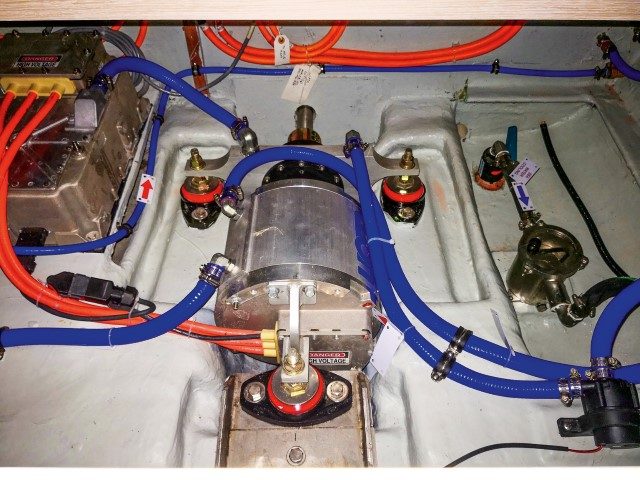
At first glance the Silent 55 looks like many other power catamarans – a tall flybridge above a large squared-off saloon and spacious lounge decks fore and aft. Looking closer revealed the reason for the large topside structures – these areas host the solar panels.
The overall shape is fairly sleek and low-slung to reduce windage. But to maximise the extensive inside space requires upright topsides and squared bulkheads in the saloon which somewhat compromises the aesthetics. So it doesn’t have the smooth curves of a Tesla electric car but, like these vehicles what counts is under the hood.
 Solar power comes from 30 panels rated for approximately 10 kilowatt-peak output, controlled by a smart solar regulator – a maximum power point tracking (MPPT) unit that controls the energy going into the lithium batteries, giving stored power for night-time cruising while a 15kVa inverter provides DC/AC power for all household appliances.
Solar power comes from 30 panels rated for approximately 10 kilowatt-peak output, controlled by a smart solar regulator – a maximum power point tracking (MPPT) unit that controls the energy going into the lithium batteries, giving stored power for night-time cruising while a 15kVa inverter provides DC/AC power for all household appliances.
“What this represents to the yachtsman, among other features, is the ability to cruise for many hours at normal speed and throughout the entire day and evening at reduced speed,” says Köhler.
Apartment-style saloon
Cruising catamarans attract buyers for their comfort and stability. The two hulls allows them to carry heavy loads and of course contain a lot living spaces. Looking around the Silent 55, it doesn’t disappoint in any of these areas.
Walking inside from the sheltered aft deck reveals a spacious saloon to me with galley at the doorway, dinette on the forward port quarter and steering console opposite. Ahead is a deck level owner’s suite, an unusual feature; and up to six cabins can be optioned on the Silent 55.
The U-shaped galley on the portside comprises a deep sink, electric cooktop, dishwasher and worktop space nearby on the starboard side as well, making it an effective cooking space with lots of cupboards; ideal for those blue-water voyages. Refrigeration consumes the most energy on yachts but is an essential so there’s a drawer fridge; in addition our review boat had a large upright household fridge.
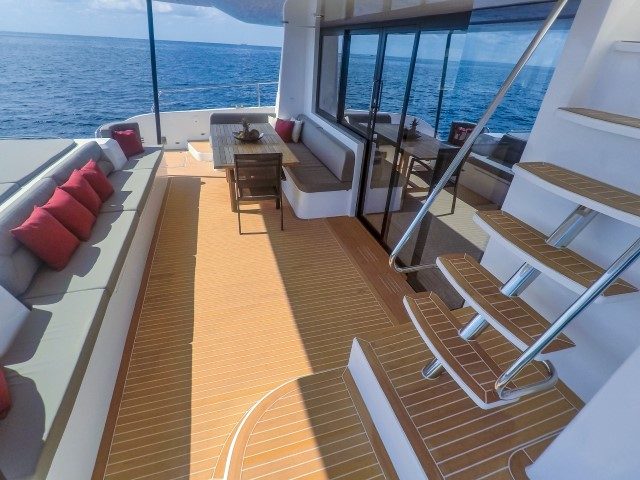
The other big consumer is air-conditioning which is a 50,000 BTU reverse-cycle unit on the Silent 55 – it heats as well as cools. Most usefully, there’s a water-maker powered by the solar-electric system, which produces 100l/per hour, so enough to supply a boat load of passengers. Other good galley features include a sliding window that opens aft to the outside dinette area.
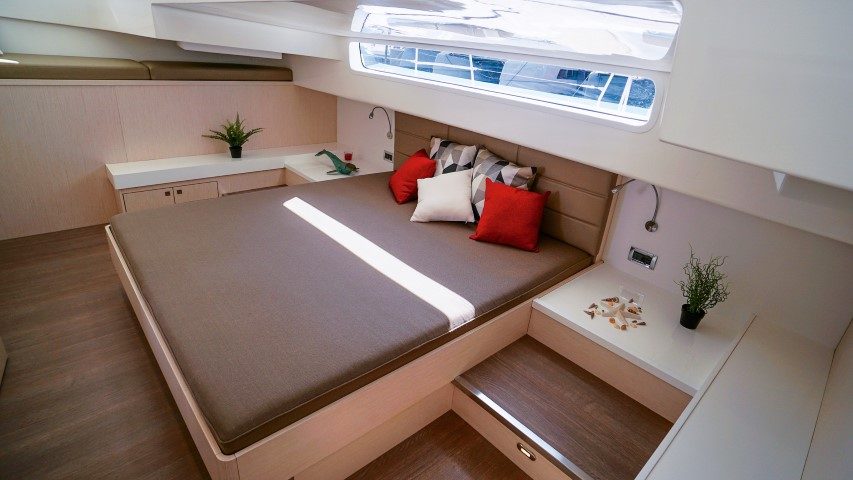
Moving to the middle of the saloon takes me to another set of large cupboards that also houses the retractable television; ideal for viewing from the dinette which has an adjustable table (making it a day bed) and surrounded on two sides by settee space. A step up on the starboard quarter is the navigation station which offers clear views all around and has a steering wheel with two seats.
An array of Raymarine instrumentation controls the Silent 55, including the essential autopilot. The main controls are the throttles and beside them two joysticks for the Lewmar 10kW thrusters located in each hull. The other essential screen is the small power consumption one which uses simple bar charts to show usage.
No appreciable sound came from the motors, prompting me to go below for a look at them. Opening the engine hatch revealed the UQM motor – similar to those used in forklifts – and it emitted a humming sound about as loud as an average human voice; 50 decibels.
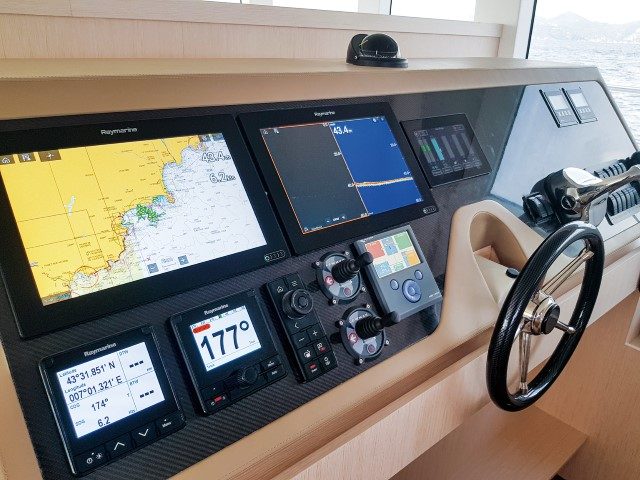
The American UQM company supplies a significant part of the electric marine sector and claims the mantle for the world’s highest powered electric outboard (180hp). With a background in the automotive industry, powering a fleet of BMW E1 electric vehicles for California and the GM Precept Hybrid car are among many other UQM projects.
Back on the flybridge I took over the steering and pushed the throttles down and watched our speed increase to 10 knots, with consumption at 80 kilowatts, and no vibration felt throughout the hull. At this rate, and combined with the dull day, our batteries were discharging so to combat this the optional 100kW Volvo generator is programmed to kick-in to add amps to the system when batteries fall to 30%.

But in sunny weather, running at 5 knots, the Silent 55 can do 100 miles daily. The hydraulic steering wheel felt heavy, something that the company was going to rectify, as it consumes more energy from the autopilot. But turning the wide catamaran was done easily, as it gently glided around; with no smoke or noise. All I could hear was the water streaming past the fibreglass hulls and the feel of the wind on my face.
2019 Upgrade to Silent Yacht 55
The Cannes 2019 boat show saw the arrival of an upgraded Silent 55. Key improvements include higher-powered 250kW motors as standard and increased stored power (210kWh batteries compared with 70kWh).
More efficiencies have been found through a redesigned drive-train that minimises friction and reduces mechanical noise. Following customer feedback some interior design improvements have also been made, says Köhler. “We did these updates and changes because we always try to improve and to install the best and latest technology available to satisfy our clients. We have built one new SILENT 55 already and we’ve got three more orders for this model, which shows that we’re heading the right direction”.
/>
‘Behemoth’ is a word which springs to mind or, perhaps more nautically, ‘leviathan’.
White Pointer has earned the respect of discerning customers in New Zealand and Australia, attracting a loyal and ever growing following for its high-quality, rugged and totally dependable aluminium trailer boats.
The hardtop SP635 shares the same underpinnings as the popular SF 635 which was a completely new model back in 2020.
The pride and joy of a multi-generational family, Bliss resides on a pier that’s home to a couple of other Elite motor launches – Sandspit Marina is a hot-spot for the Bill Upfold-designed vessels, with several calling this small marina home.